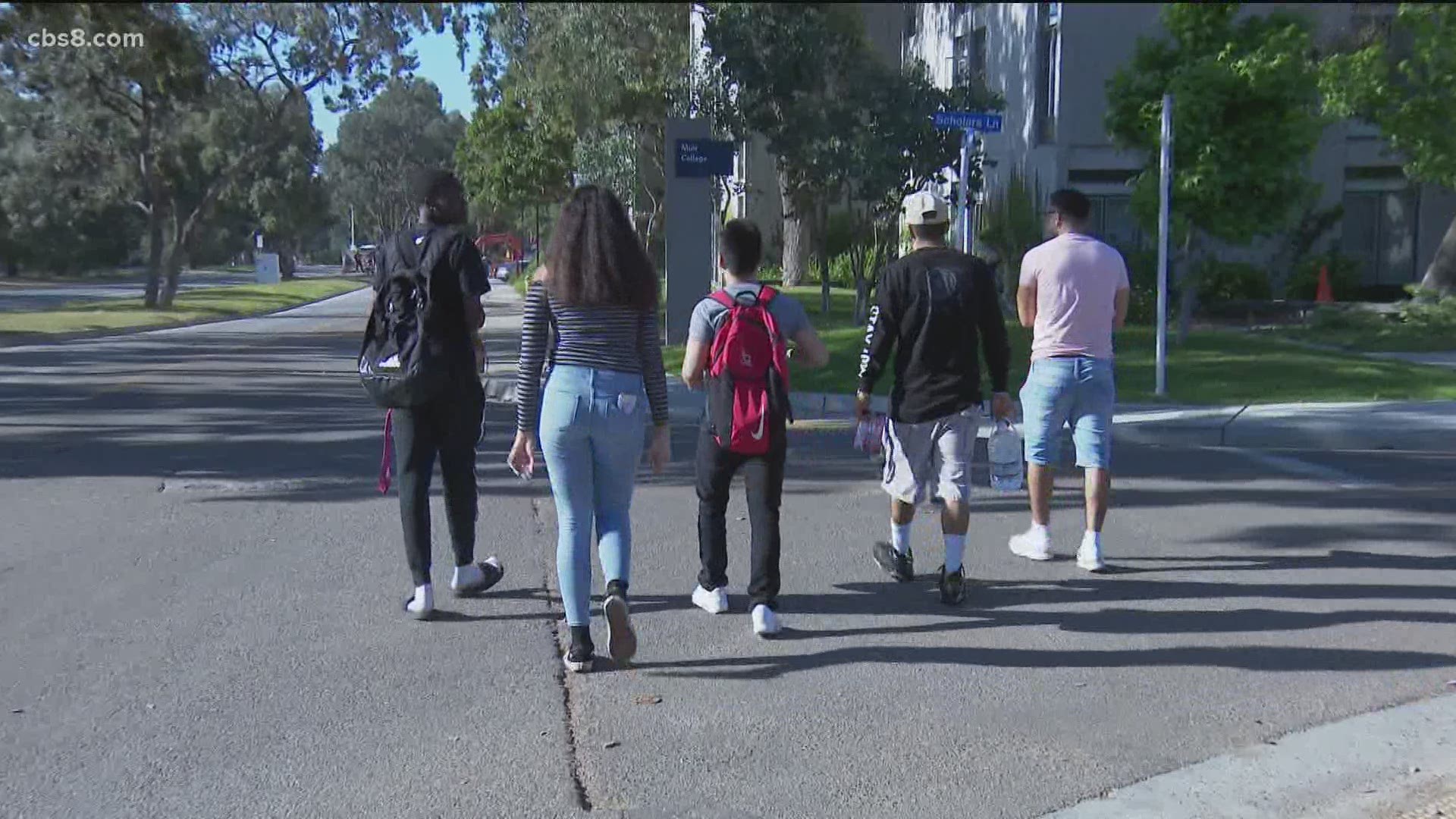SAN DIEGO COUNTY, Calif. — UC San Diego on Tuesday announced its Return to Learn program would allow mass testing of thousands of students, faculty, and staff on campus on a recurring basis for COVID-19.
According to the university, the initial phase of the program will begin this month with the 5,000 students currently living on campus.
If successful, it could be subsequently expanded to the rest of the UC San Diego community.
The new program includes plans for exposure notification and isolation housing for on-campus resident students who test positive for the virus.
UC San Diego hopes the program will allow it to resume in-person activities when fall classes begin in the fall.
“I mean, I’m not going to sit around someone who has coronavirus,” said Diego Sanchez.
Sanchez said he would not return to class until he knows it's safe. The college freshman is still living in a campus dorm, and could be among the first to be tested for COVID-19 as part of the Return to Learn program.
“This came about by asking the question: What would it take to bring all the students back to campus like we've had for the last fifty, sixty years?” said University Chancellor Pradeep Khosla.
Chancellor Khosla said it took teams of molecular biologists and infectious disease specialists to come up with the idea.
It could ultimately result in the testing of at least 60,000 students and staff.
How will it work?
“We would be setting up stations at the dormitory, at the front end of the dormitory,” he said.
Stations will be equipped with containers consisting of a single clean nasal swab. Students will pick one up, swab their own nose, and drop off the sample in a collection box. Results would come in the next morning.
Anyone who tests positive would be expected to isolate.
It doesn't stop there.
“Then contact tracing takes multiple forms. It would be like, who are the people you were with, and then we test them,” Khosla explained.
Are there enough tests to go around?
Yes, according to Khosla, thanks to the UC San Diego Medical Center where preparations are underway. The hospital is ready to deliver 1,200 tests a day, for as long as necessary, Khosla said.
“I mean this is our power,” he said.
“I feel like it would be reassuring the fact that they were tested as well as me,” said Dereck Cattouse, who still works at the campus bookstore.
Like those in the dorms, Cattouse can't wait to get back to school knowing there's a plan in place.
“Everyone has to get tested,” Sanchez said.
The university said only medical professionals and public health officials will know who tested positive for coronavirus.
How the UC San Diego Return to Learn Program works
In the initial phase, scheduled to begin May 11, self-administered, nasal swab-based COVID-19 tests will be made available to the more than 5,000 undergraduate and graduate students who continue to reside on the UC San Diego campus.
The program team will also look for signs of the coronavirus in residential wastewater and surface collections.
Once enrolled, a participant will go to one of several designated sites on campus to pick up a clean nasal swab in a specimen collection container. Using a downloaded barcode-reader app on a smart phone, the participant will scan the unique barcode on the container, linking their cell phone number to the specimen and generating a time stamp.
The participant will then swab the inside of their own nose, drop the swab in the container and leave it in a collection box to be picked up by program coordinators.
The swabs will be tested for the novel coronavirus, SARS-CoV-2, at the Center for Advanced Laboratory Medicine at UC San Diego Health.
The initial phase of the program will allow the team to optimize operations so that, if successful, the program might be broadly expanded to potentially test all UC San Diego students, faculty and staff, approximately 65,000 people, on a monthly basis, beginning as early as September or soon thereafter.
The data collected about the virus is expected to inform an epidemiological model that reflects UC San Diego, its facilities, housing configurations, and the way people move and interact around the campus.
This knowledge may help university leaders better understand how to most effectively detect cases early, mitigate transmission risk, and guide key decisions regarding housing, class sizes and classroom configurations.
What happens if coronavirus is detected
Any participant who tests positive for SARS-CoV-2 will be notified and advised to seek medical care. The program’s Case Finding and Contact Tracing team, led by Anderson, will also try to identify and notify persons with whom the infected person may have had close contact in previous days — an effort known as exposure notification. In accordance with federal and state regulations, San Diego County Public Health will be notified about positive cases.
UC San Diego’s Student Health Services and UC San Diego Health are the first in the University of California system to share an integrated electronic medical record system, which is expected to help streamline test ordering, notification, and patient care.
Participant privacy is a priority.
Only medical professionals and public health officials who need to know the identity of those who test positive for SARS-CoV-2 will have access to identifying information. Otherwise, specimens and records will be managed by barcode and an associated alphanumeric code, and only aggregate data without identifying information will be made available to researchers monitoring the presence or absence of the virus on campus.

